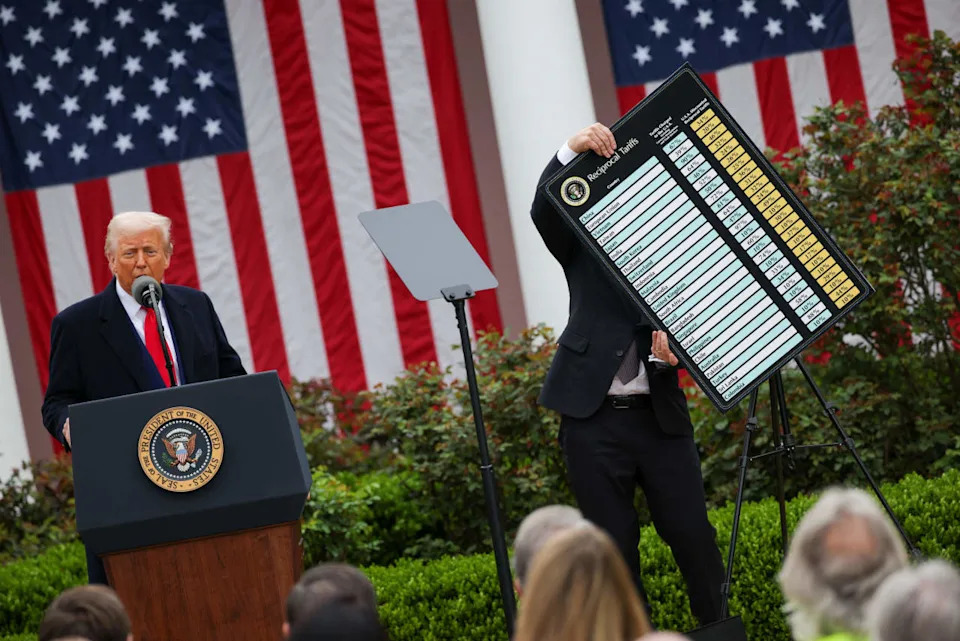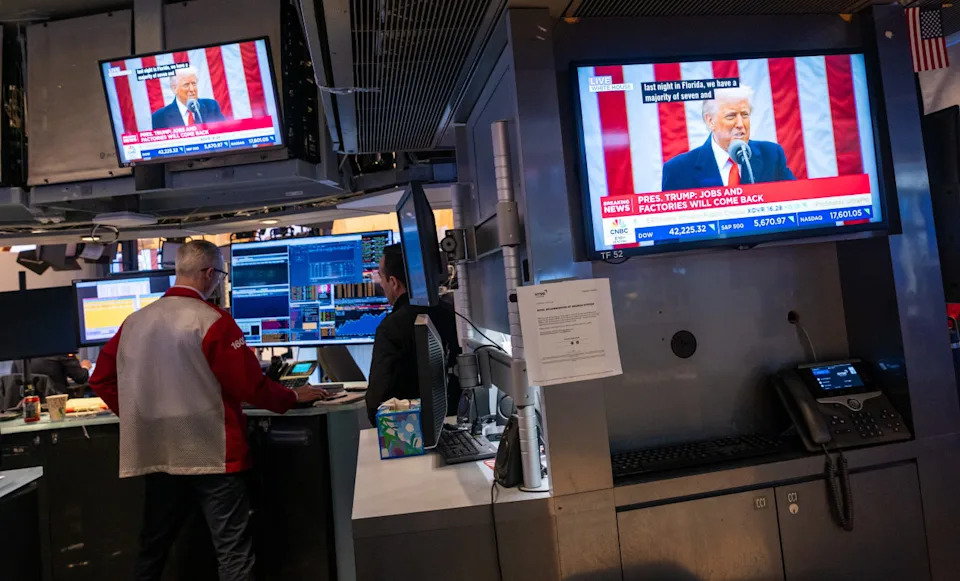Trump’s Tariffs Aim to Create a New World Economic Order
The U.S. is moving to blow up the global trading order it built, ushering in an uncertain new era.
President Trump’s highly anticipated announcement Wednesday represents a high-stakes gamble to transform a global economic relationship that Trump for decades has said ripped off the U.S.—even as the American economy had emerged from the pandemic as the envy of its rich-world peers.
The president’s moves raise the specter of a stagflationary shock that increases prices while putting more economies, including the U.S., at risk of recession.
Trump stunned markets by announcing a suite of tariff hikes on major trading partners, including 20% for the European Union and 34% on China. The tax on imported goods, which also includes at least a 10% across-the-board increase on all countries, will raise overall weighted-average tariffs to 23%—the highest in over 100 years—from 10% before the announcement and 2.5% last year, according to JPMorgan Chase.
Economists said Trump’s policy shift, if it isn’t rolled back, could rival President Richard Nixon’s 1971 decision to overturn arrangements created by the U.S. and its wartime allies during World War II, when Washington had agreed to exchange dollars for gold at a rate of $35 an ounce.
It would mark “probably the biggest attempt to fundamentally reshape the tax-trade structure in the U.S. since Nixon took us off the gold standard in the early 1970s,” said Michael Gapen, chief U.S. economist at Morgan Stanley.
Gapen said his bank had been advising clients that markets were too complacent about the risks of bigger and broader tariffs, but Wednesday’s announcement “was more expansive than even we thought.”

The president’s mercurial and chaotic rollout of his trade plans, which already have included 20% tariffs on China, 25% tariffs on auto imports and 25% tariffs on Canadian and Mexican goods that aren’t covered by an existing trade agreement, has chilled business investment and consumer sentiment.
“They just announced a major tax hike, mostly on the corporate side, but as with most corporate taxes, they will be translated into higher prices to the consumer. And you don’t grow an economy with higher taxes,” said Steven Blitz, chief U.S. economist at GlobalData TS Lombard.
The tariff increases announced Wednesday are particularly drastic because they don’t have exemptions for the two-thirds of imports that normally come in duty-free, such as coffee, tea and bananas, which aren’t produced in significant quantities domestically, said Douglas Irwin, a trade economist and historian at Dartmouth College.
They will cover a far wider array of goods than during Trump’s 2019 trade war with China. Nike produces half of its shoes in Vietnam, which faces a 46% tariff. A web of consumer-electronics makers across China, Taiwan and South Korea will face tariffs of at least 25%. The tariffs exempt oil, gas and refined products.

The tariff hikes raise the risk of a sharp hit to consumers’ inflation-adjusted incomes that could tip the U.S. economy into recession this year, said Diane Swonk, chief economist at KPMG. The suite of tariffs announced amounted to a “worst-case scenario” relative to expectations in the run-up to the announcement, she said.
Moreover, it isn’t clear how trading partners will respond, meaning uncertainty could remain elevated for some time to come. “If the goal is to get firms to relocate here, this doesn’t accomplish that, because you don’t know for sure in three to five years, by the time you build a plant, will the tariffs still be intact,” said Swonk.
The U.S. current-account deficit, a broad measure of trade and income from overseas, in 2024 reached $1.1 trillion, underscoring to Trump and his allies the need to revamp global trade.
Tariffs could bring in new revenue but at a potentially steep cost to financial markets. Lofty asset prices over the past two years have reflected investors’ bets that the U.S. economy was well positioned relative to its peers, given advances in technology and the prospect for an elusive “soft landing,” where inflation declines without a sharp increase in unemployment.
Trump inherited an economy with steady growth and a declining rate of inflation but vulnerabilities from a frozen housing sector, cooling labor market and richly valued stock market.
Trump has long regarded trade deficits as a sign of economic weakness. But in the Trump administration’s attempts to narrow those deficits, foreign countries could reduce their purchases of U.S. Treasury securities or have less surplus capital to park in American stock, real-estate and private-debt markets.
“The real pain from this event will be the breaking down of the capital flow agreement that we had with the rest of the world,” said Blitz. “This idea that you can break trade, and not break the capital flow side, is a fantasy.”
If the tariffs remain in place for a prolonged period of time, inflation using the Federal Reserve’s preferred gauge could rise from 2.5% in February to 4.4% at the end of this year, according to economists at UBS. They see inflation declining after that, to 3% by the end of 2027.
In that scenario, the U.S. economy could see growth stall this year and turn negative in the first half of next year, meeting the technical definition of a recession. The unemployment rate, at 4.1% in February, could hit around 5.5% next year.
That combination of weaker or stagnant growth and higher prices would put the Fed in a very tricky spot, especially since the U.S. economy has come off of a period of elevated inflation. Officials would have to decide whether to focus more on the risk of higher inflation, which would call for tighter policy, or of rising unemployment, which would call for looser policy.
At issue is how central banks should navigate a negative supply shock—for example, a surge in oil prices. Negative supply shocks limit the ability of the economy to produce goods or services. Prices suddenly rise for some producers but are offset by lower inflation-adjusted incomes that weigh on overall economic growth.
Standard monetary policy theory says if these shocks are expected to raise prices on affected goods as a one-time hit, policymakers should “look through” the shock—in other words, don’t do anything different from what you were planning to do with interest rates before the shock hit.
But that is easier in theory than in practice. Officials could be hard-pressed to declare price increases from tariffs as temporary if they set in motion a reordering of global production processes that takes years to play out.
The upshot is that Fed officials could wait to see economic activity slowing and unemployment rising before they attempt to cushion the hit to demand with lower interest rates.
UBS economists said they think the Fed would cut rates gradually at first because of the risks of higher inflation. But they foresee more Fed rate cuts after unemployment rises and growth weakens, leaving short-term interest rates more than two percentage points lower at the end of next year.
Write to Nick Timiraos at [email protected]

